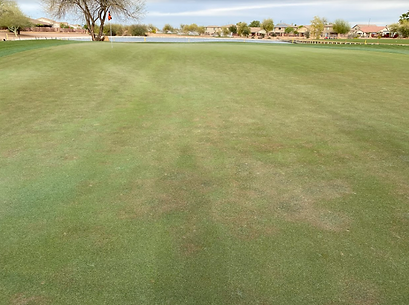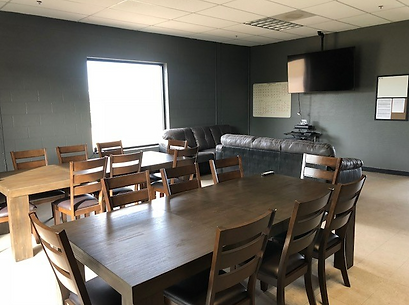Transition Improvement
Seville has quite a history of poor summer transitions due to heavy clay soils, bad water quality, and other agronomy practices that are hard to pinpoint due to not being there throughout the life of the property. I assumed my position as Golf Course Superintendent at Seville Golf & Country Club in the winter of January 2019, during the winter overseed season. Golf course conditions were great at the time; however, as the late spring and summer approached, turf conditions rapidly declined. Below references troubled photos of 2019 and 2020, followed by current ones from summer 2022. It was also brought to my attention that in the summer of 2018, they outsourced a contractor to auger and sand inject fairways on holes 11, 12, and 13 due to the lack of Bermudagrass base. It takes years to improve the quality of the Bermudagrass base when overseeding is done annually. The following inputs are what drastically improved the health and percent coverage of the Bermudagrass:
-
Mowing heights dropped to 0.300” by February 1st in addition to more frequent mowing to allow sunlight to the Bermuda canopy.
-
Cultural practices implemented monthly from January through June--most importantly, solid tine aeration and vertical mowing.
-
Skilled watering practices: Bermuda loves water, especially in February, March, April, May, and June in order to successfully transition from ryegrass to Bermuda. Several irrigation management techniques should be used to achieve deep watering, but this must be done strategically, as to minimize disruption to playing conditions while still achieving a dry, firm golf course.
-
Build dry irrigation programs so chronic dry areas can receive adequate moisture without overwatering the whole golf course.
-
Use proper wetting agents.
-
Utilize portable irrigation sprinklers to move throughout the golf course to allow deep, low-volume irrigation in areas that require more water.
-
-
Some growth regulators used in the winter impact the health of the Bermudagrass; therefore, the usages of more practical ones improve summer transition.
-
Water treatment: currently injecting acids to lower pH and counteract bicarbonates in the water.
-
Propagation techniques to repair seriously damaged areas such as using verticut clippings and aerification plugs to regenerate the turf naturally. Also, soil remediation, while being a more expensive method, is beneficial, as is sodding chronic trouble areas.
-
Incorporating sand into the fairway soils--for instance, drill & fill, sand channeling, and the implementation of annual topdressing on fairways will drastically improve transition and summer conditions.


#6 Approach: Before (June 30, 2020) & After (June 30, 2022)


#10 Approach: Before (June 30, 2020) & After (June 30, 2022)


#13 Fairway: Before (July 10, 2019) & After (June 30, 2022)
Rapid Blight Eradication
Seville has experienced 15+ years of rapid blight disease on the TifEagle greens overseeded with Poa Trivialis. The Poa Triv is highly susceptible to rapid blight, as the disease thrives in soils and irrigation water with high sodium levels.
In 2022, I implemented a different approach to managing the disease:
-
Implemented green flushing methods with micro emitter / low volume irrigation. This enabled sodium levels to be lowered by 50% which could not be achieved with overhead irrigation.
-
In conjunction with this flushing method, irrigation water was treated with N-pHuric acid.
-
Needle tine aeration, sprayable acids, and gypsum were applied prior to flushing.
-
Calcium was also injected during the flushing cycle.
-
15% of Seaside II Creeping Bentgrass was added to the overseed on the greens which is rapid blight resistant.


#17 Green: Before (March 2021) & After (March 2022)


#18 Green: Before (March 2021) & After (March 2022)


Low Volume Water Leaching
Read the corresponding feature in the USGA article “A Smart Way to Leach Those Salts Away,” by Brian Whitlark, Regional Director, West Region.
Better Billy Bunker Installation
Seville’s greenside bunkers were constructed seven years ago, and the fairway bunkers are from the original construction in 2001. Bunker reconstruction has been top on the members’ list over the last few years, but capital funding has not yet been allocated to this facet of the property. However, 2023 has a strong outlook for approval. We decided to redo the practice facility first as an experiment on the performance of bunker liner selection and sand specification. Furthermore, since the practice bunkers are used more often, and experience more wear and tear, they were top priority. In 2020, we rebuilt the practice bunkers using Better Billy Bunker. Wadsworth Golf Construction Co. performed the work, which was supervised by me and my team. The construction process is listed below.
-
Excavated and removed the existing sand, bunker liner, and drainage
-
Shaped the bunker and complex
-
Excavated and installed drainage
-
Formed final grading of base
-
Installed pea gravel followed by polymer coating glue
-
Backfilled bunker sand and assured adequate depth
-
Compacted sand on the walls of the face
-
Installed sod around the bunker and bunker complex






Desert Reclamation/Beautification
Seville was originally constructed with wildflowers as native areas in 2001 but was converted to native decomposed granite (DG) areas upon the acquisition of the property in 2008 by ClubCorp. Over the years, an abundance of volunteer trees established along with the growth of noxious weeds and undesirable plants. The overgrowth increased the course rating, and many homeowners voiced their opinions about obstruction of golf course views, weed seeds being spread to lawns, and undesirable vegetation growing along their fence line. The Club invested in the removal of this vegetation with use of a skid steer forestry/turbo mulcher, a mini excavator to dig bury pits, tractors for raking debris and grooming deserts, and manpower for necessary handwork. I managed this project; labor and equipment were outsourced. Below is a sample of before, during, and after photos of this process. In the coming years, the Club will invest in new gravel, rip-rap, and ornamental plants to enhance the beautification of the property. The photos below demonstrate the before and after results of this project.




Break Room/Shop Renovation
Upon commencing my role as Golf Course Superintendent at Seville, it was apparent the golf course maintenance facility, break room, offices, shop, chemical storage, and yard needed an absolute overhaul. First, I am a very clean and organized person and felt that if I am not comfortable working under these conditions, how could my staff be? Furthermore, the organization of the maintenance facility is a good indication of how the course is managed and maintained. It also gives vendors an indication of you as a person and your management style. Within the first few months, we transformed the maintenance facility as illustrated in just a few samples below.


Chemical Storage: Before & After


Yard: Before & After


Lunch Room: Before & After